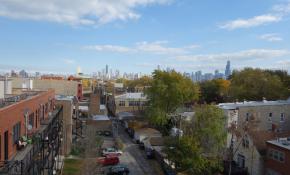On Thursday morning, as Hurricane Florence swirled toward the Carolinas, The Sun News in Myrtle Beach evacuated from its newsroom for remote locations further inland.
McClatchy has six other newsrooms in the cone of the oncoming hurricane. But those newsrooms, along with their counterparts in the chain, aren’t taking Florence on alone.
For the past seven months, Robyn Tomlin has worked to get McClatchy newsrooms in North and South Carolina to work as a regional team. Tomlin, editor of Raleigh’s News and Observer and Durham’s Herald-Sun, thinks they’re ready.
“This is a real test for it,” Tomlin said, “there’s no question.”
Many local newsrooms in the Carolinas and Virginia are connected by corporate parents — McClatchy, Gatehouse, NPR, Tegna and Local Voice Media among them. As Florence gets closer, they’re using technology, teamwork and lessons from last year’s hurricanes to cover what’s coming.
Smaller, but bigger?
As The Washington Post’s Paul Farhi reported, McClatchy’s News and Observer had 250 journalists in 1999 when it covered Hurricane Floyd. Now, Farhi reported, it has 65.
Newspaper chains such as McClatchy, Gannett and Gatehouse have continued newsroom layoffs and buyouts while working to better connect those newsrooms and remaining employees with each other through regional and company-wide initiatives.
What that likely means for the communities where Florence is headed is fewer reporters with a wider network of resources.
Related: Want to keep up with Florence coverage? Follow these local newsrooms
McClatchy’s Carolina newsrooms already established virtual teams for audience development and real-time news. And they started a team drive, team folders and a regional Slack channel.
To cover Florence, they’re adding a videographer and a visual graphic artist from Kansas City, and audience team members from the West Coast who will work the overnight shifts. McClatchy has four teams along North Carolina’s coast and another four to six teams along the coast in South Carolina, all ready to ride out the weather and report on what’s happening.
Each local newsroom has its own specific issues to cover, Tomlin said, but the regional approach means newsrooms like the one in Myrtle Beach can focus on covering the story as the rest of the team looks at the bigger picture.
Gatehouse, which has newsrooms in Fayetteville, Jacksonville, New Bern and Wilmington in North Carolina, set up morning calls with editors, said Jean Hodges, senior director of content, in an email. The newsrooms have shared Google docs and spreadsheets, and people in newsrooms in Florida, Georgia, inland South Carolina and even Pennsylvania are ready to step in if newsrooms in the hurricane’s path lose power.
Local Voice Media has newsrooms in Wilmington, Virginia Beach, Williamsburg and Hampton/Newport News that are already working together.
In Wilmington, the Port City Daily, an online newspaper and radio station, has nine full- and part-time staffers. Two will remain in town while that team and another 20 staff from the Southside Daily, HNNDaily and WYDaily update readers and listeners on the latest.
“While the national news folks do something similar,” said Jamie Paige, vice president of digital newspapers, in an email, “our relationships in the market by being local give us access to many, many more locals who know and trust us.”
Download the app
On Wednesday, McClatchy newsrooms added a special section to the e-edition with storm coverage, Tomlin said, with the assumption that deadlines, delivery problems and evacuations will make it hard for print readers to get their newspapers.
Like with last year’s hurricanes, newsrooms are taking advantage of digital tools to keep people up to date with accurate information.
McClatchy's North Carolina and South Carolina newspapers are also encouraging readers to install their apps to get push alerts, which the newsrooms are planning to use to update people on the emergency conditions in a way that takes up less bandwidth.
Local Voice Media’s publications started storm-related newsletters and on Thursday, launched a live blog. And Tegna’s newsrooms are using Verify, a fact-checking project around user questions, to dispel hurricane myths and misinformation, including why hotels don’t have to take pets and why you should buy water before the storm.
Harvey, Irma, Maria, Florence
Leave your car keys in the office in case the parking lot floods while you’re out reporting.
Don’t just get snacks and water, get non-perishable meals.
And give employees time to get their families, homes and pets to safety before the storm hits.
Little things can make a big difference for coverage and news teams, said Ellen Crooke, Tegna’s vice president of news. Tegna has stations in seven stations in the hurricane’s path, and it’s applying lessons from last year’s hurricanes to make sure everyone is ready.
Tegna has sent an additional 80 people into stations in the hurricane’s path, including photojournalists, multimedia journalists, drone operators, producers and digital journalists, Crooke said.
Teams are also assigned to each station’s digital properties and working remotely to keep them running. Every four or five hours, each station checks in, she said.
When Houston’s KHOU flooded last year, staff had to evacuate the newsroom.
“We know that the worst imaginable situation can happen,” Crooke said, “and we’re preparing our stations for that with strong backup facilities.”
In Texas last year, NPR set up daily calls with local member stations. As Florence headed for the East Coast, those calls started with newsrooms in the Carolinas.
Since last year’s hurricanes, NPR has added a reporter to an early shift and one to a late shift to keep up. Member stations in North Carolina created their own special programming, working together to provide updates for listeners.
“That degree of cooperation that early, before the storm, before the story even really develops, that’s new,” said Luis Clemens, an editor on NPR’s national desk. “That’s different.”
Being flexible, making sure newsrooms are communicating and sharing their work feels like a small investment, he said, that yields a high reward.
“Look, Florence doesn’t give a darn about state borders,” Clemens said. “The storm is going to cross state lines, county lines, city limits, and when rivers overflow, they don’t just stick to the banks.”









